In the season just gone, PSV Eindhoven finished in a disappointing 4th place in the Eredivisie behind old rivals Ajax Amsterdam and Feyenoord Rotterdam, and, quite surprisingly, AZ Alkmaar. There are several reasons behind the poor performance: the tactics were far from perfect, they lost their two most important players at the halfway point of the campaign, and they were just unlucky in many situations. However, another factor should be taken into account: recruitment, as maintaining a deep and balanced squad is a core element of a great performance of a team. In this data analysis, we will investigate PSV’s weak spots in the previous season, give an overview of the current 2020/21 squad, and also aim to identify some potential changes in personnel during the summer.
1. 2019/20 squad performance
First of all, let’s investigate the statistics of the PSV players from the last season. To have a realistic outcome, we will include only those who played at least 900 minutes in the Eredivisie on one side and played 900 minutes for PSV on the other one. We declared the ten most important types of statistics for all positions, measured the % difference between the PSV players’ figures and the league average, and finally calculated an average difference for all positions. The results are visualised in the below graph.

The size of the circles indicates the difference from the average in every case. By this, we can see that apart from four outstanding figures (RB, AM, LW, CF) the PSV players’ performance was rather mediocre. The left-back role finished only 1.28, while the central-backs 2.05% above the average – and this are rather decent numbers compared to those described in the followings.
Defensive midfielders
As PSV used a double pivot in the central areas in the majority of times, we decided to use a more simplified categorisation to declare the positions – meaning that we divided the midfielders only to defensive and attacking ones. PSV had several well-rounded and massive players in the defensive areas but the players finished 0.57% below the league average. The below chart shows that the differences were significant in both directions: the PSV midfielders were effective in aerial duels (74.8% above), passes (24.8% above) and progressive passes (24% above), while performing way worse in offensive duels (40.5% below), progressive runs (42.4% below) and attacking actions (25.7% below).
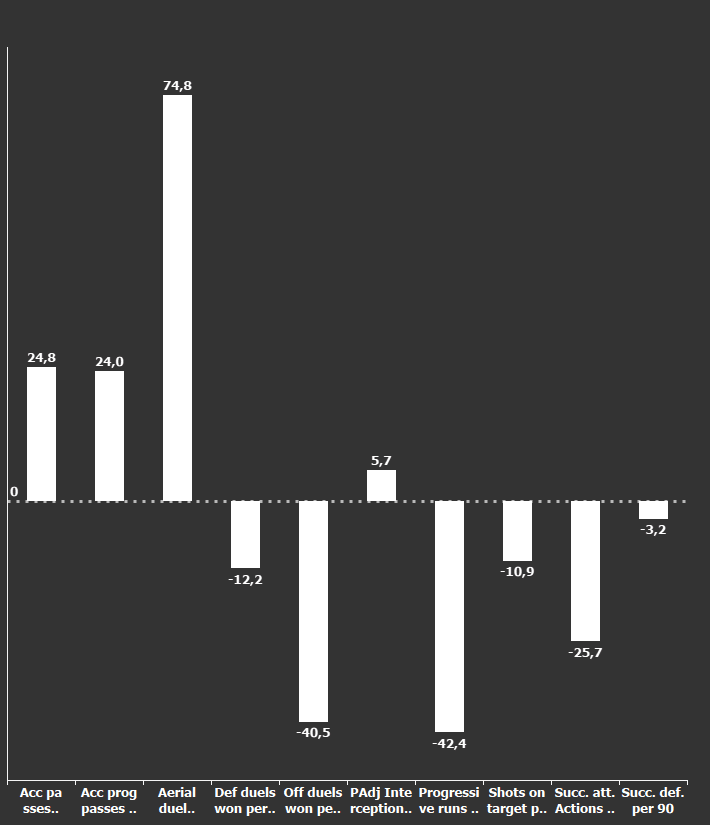
Goalkeepers
As far as goalies are concerned, things start to become worse. The first and most significant issue was that the spot was anything but secured in the previous season: Zoet was a starter in the first several games but than Unnerstall got an opportunity and eventually Zoet was loaned out to Utrecht where he was the first-choice ‘keeper throughout the whole season. They had a 3.94% better save percentage combined then the average and had 29.39% less expected goals but obviously, the latter is not an indicator of only their performance. Neither is the number clean sheets, however, the 25.66% gap between the PSV ‘keepers and the average is far from enough for a title contender.
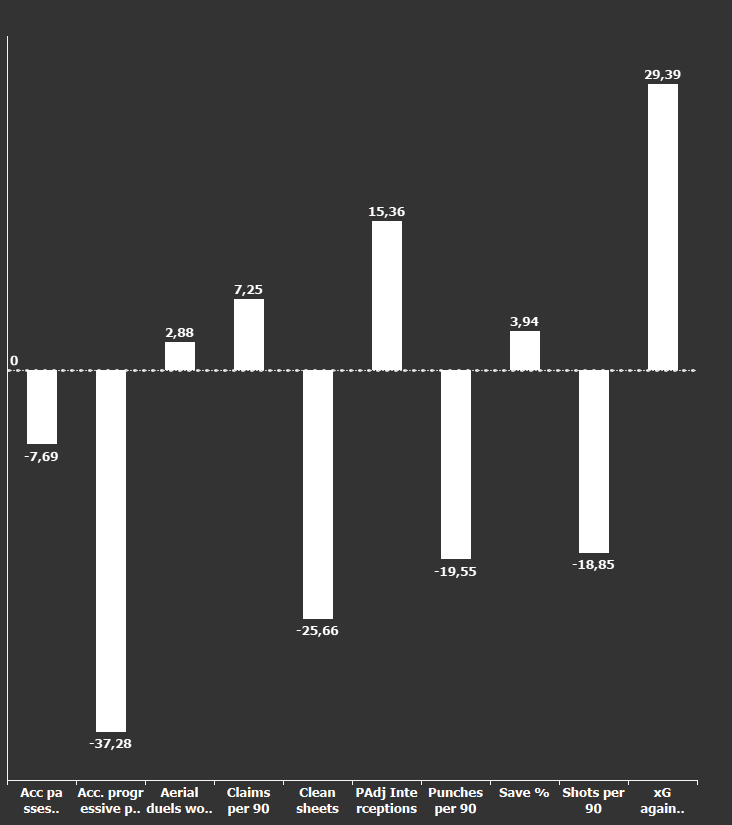
Right-wingers
Based only on the statistics, the biggest problem is in the right forward position. With 78.12% fewer expected assists, 50.96% fewer accurate passes to the penalty area and 19.25% fewer dribbles, this role seems to lack the most value. However, it must be pointed out that in the previous season Steven Bergwijn, Bruma and Cody Gakpo all played on the right-wing but not enough minutes to be included in the comparison. The only one with 900+ minutes is Ritsu Doan (1295 mins) whose performance is still not what the fans and the staff require from him.
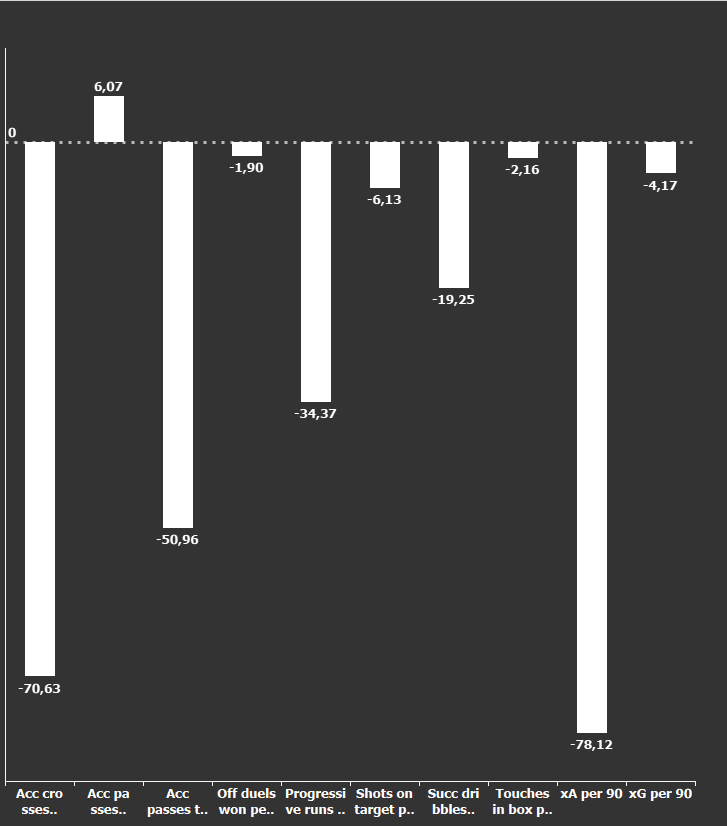
Apart from these less optimal performances, we also have to mention one area where the team suffered a lot of damage during the season. In January 2020, Steven Bergwijn joined Tottenham Hotspur in the Premier League and by this, PSV immediately lost one of their key players. The Dutchman contributed to 12 goals, had 5.73 successful attacking actions, 3.28 successful dribbles and 2.64 passes to the penalty area per 90 minutes, with this serving as the main creative force of the collective. His departure was obviously just an extra headache for the coach and the personnel, and the vacancy has still not been filled perfectly. It will be one of the main tasks for the 2020/21 season – and Roger Schmidt in particular – to find the optimal replacement of the winger either within the current squad or in the transfer market.
2. 2020/21 provisional squad
After revealing the weak spots of the squad from the previous season, let’s see how the provisional squad for the 2020/21 squad looks like in the time of speaking. The below map shows all the currently available players that new head coach Roger Schmidt will be able to use – the size of the circles indicate the minutes played in PSV Eindhoven in the 2019/20 Eredivisie campaign. We used the 4-3-3 formation again which can look more like a 4-2-3-1 in some cases, not yet taking into account the arrival of Schmidt and his possible changes in the tactics (a topic that will be covered in a separate analysis).
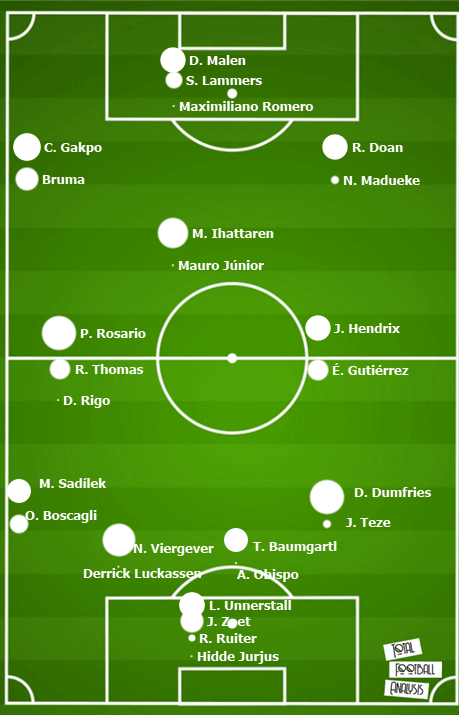
The first thing that grabs the eye is that there is a quite low amount of big circles on the pitch, meaning that the strongest eleven has only a few high-quality backup players to count on. This factor is even more visible in the below graph that represents the playing minutes of each squad members. Interestingly, only four of them had more than 1800 minutes in the Eredivisie throughout the campaign: P Rosario, Denzell Dumfries, N Viergiever and Mohamed Ihattaren. The average of the minutes spent on the pitch in a PSV shirt by the current 2020/21 squad is 890.23: no need to explain any further how new and inexperienced the team is at the moment (even if we consider that the players who spent the last season on a loan will affect the figures negatively).
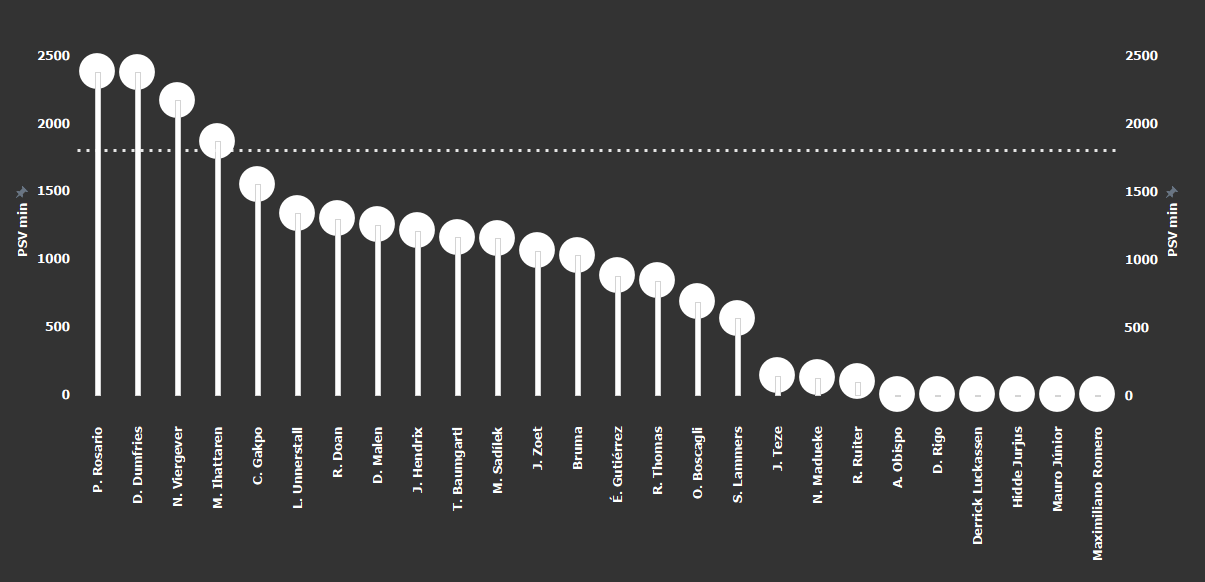
Another important aspect of building a squad is for how long the club can plan with each player. Visualising the personnel in a matrix, based on their ages and the remaining years of their contracts, the results are fascinating just again.
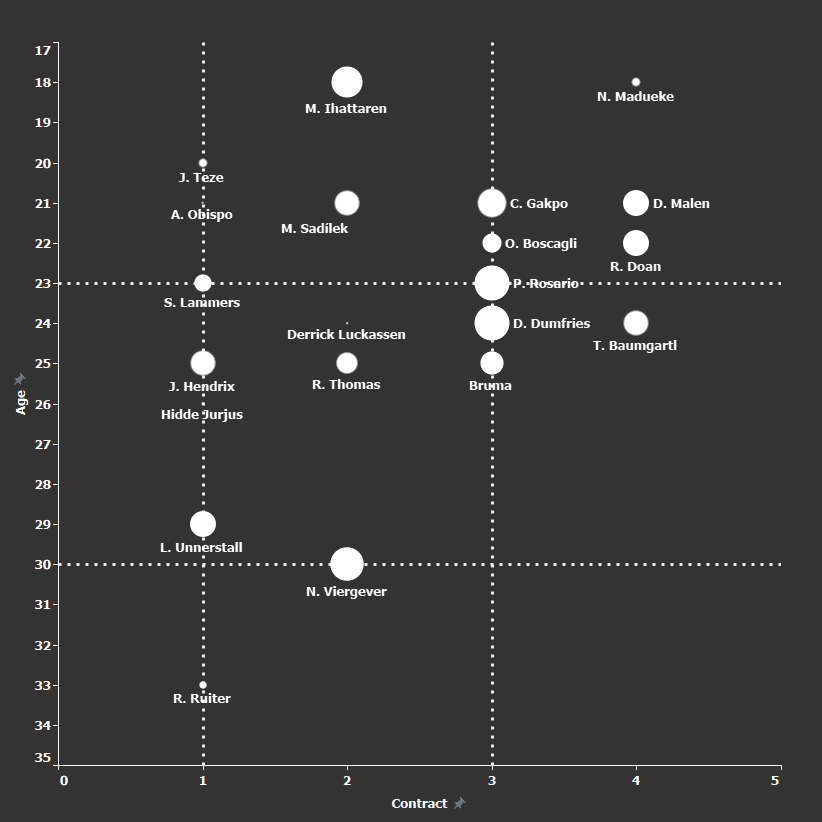
In this matrix, we divided the players to nine categories, from which the right upper corner is the best anyone can belong to, as this cluster contains those under-23 footballers who have at least three more years on their contracts. At the time of writing, PSV can count six players in this box which is around the third of the whole squad – this, in itself, is not a bad ratio, but there is another, totally different aspect that must be managed as a priority within the club: seven contracts will expire in the summer of 2021, after which the players will become free agents. If the club does not want to lose on these contracts, they have to either sign a new agreement with the candidate or try to sell them in the 2020 transfer period. To sum it up, PSV has the risk of losing seven players which will probably force them to let go of some of them in the next few months, and the squad will become even more narrow and vulnerable.
3. Potential changes
Having investigated the weak spots of next season’s provisional squad, now let’s concentrate on the possible solutions either in the short or in the long run. In general, the club can plan in three different ways regarding their recruitment:
- Players coming back from a loan spell;
- Youngsters/academy players eligible for selection;
- Signing new personnel from the market.
Loanees
The quickest and most practical option is to take a look at returning players and find out how can they be integrated into the squad. Obviously, these decisions depend on various factors eventually, but measuring their performance from the last season is a good enough starting point, so that is what we will do. PSV will see a total of seven players returning from loan, four of which from either the first or the second tier. As the most problematic positions have already been declared, we will pay attention to only those players who can be a significant help in those areas of the pitch.
In the goal, Hidde Jurjus will come back from a season at De Graafschap, with quite an average performance behind him. It is difficult to see that he can become a regular starter in the first squad of PSV. Defenders look a bit more promising, with Derrick Luckassen and Armando Obispo both available at the moment in the centre-back position. The latter is the more interesting profile: the Dutchman registered 3.41 successful aerial duels (44.04% above average), 7.41 interceptions (+6.09%) and 0.72 shots blocked (+16.26%) per 90 minutes, all very promising figures from the 21-year-old from a loan spell in Vitesse.
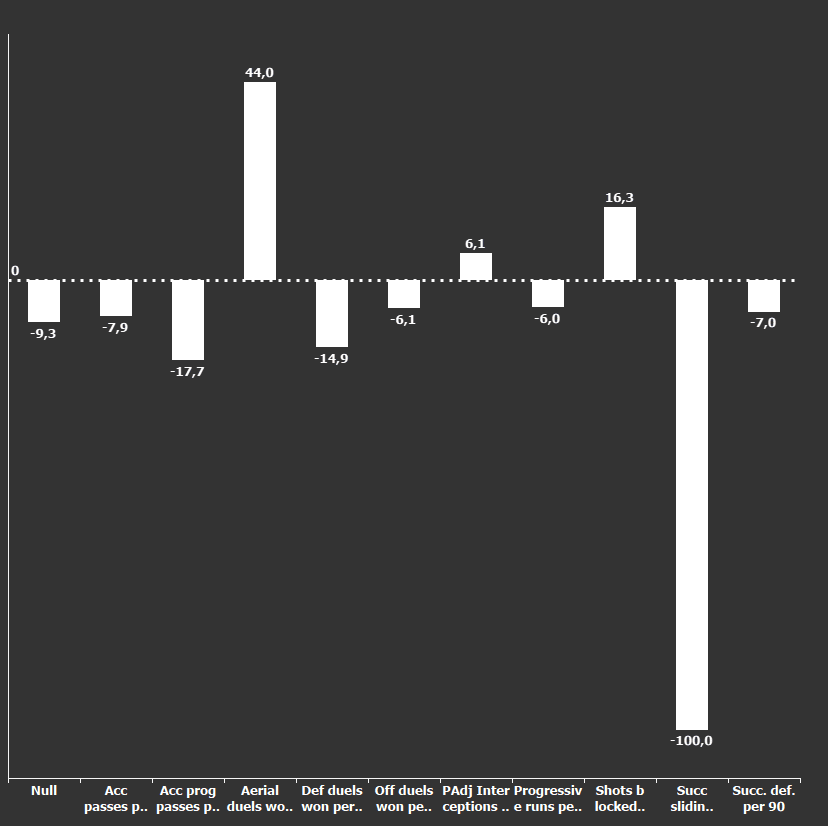
In the defensive midfielder role, Dante Rigo can already show up 137 minutes in a PSV shirt in the Eredivisie from the previous seasons and will strive to add a lot more to that for sure. His statistics, as indicated in the next graph, are below average altogether but his 11.26 successful defensive actions (11.73% better than the league average), 5.28 defensive duels won (+11.15%) and 0.3 shots on target (+31.15%) per 90 suggest that Rigo can add some quality to the midfield.
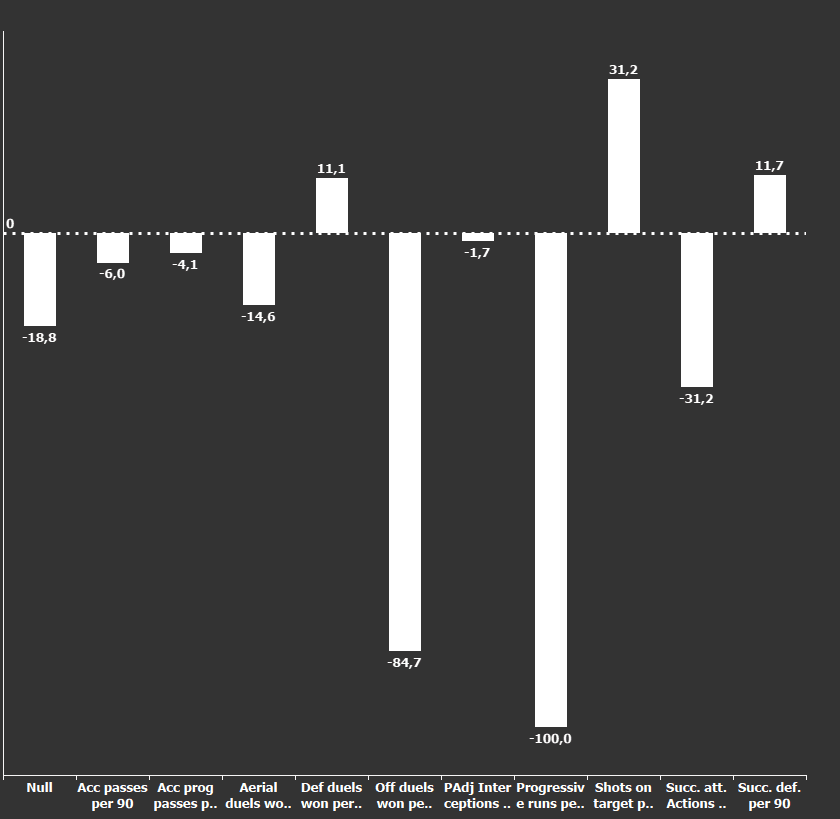
Youngsters
Another valid approach is promoting more talents to join the first-team squad and grant them the opportunity to show what they can add to the team’s performance. Dutch teams – led by Ajax and AZ – are well-known for their youth development and PSV is not any different from this perspective: enough to think about the integration of Mohammed Ihattaren, who managed to become the first name on the team sheet in less than a year, or the already discussed Steven Bergwijn who joined the PSV academy in 2011 and reached to the highest possible level of football within nine years and is now playing in the Premier League.
Obviously, there are plenty of youngsters who are eager to get an opportunity in the next season but based on their statistics in the second team, there are two talents who rise above the rest and who could most probably ensure the most support in the weakest areas of the senior squad.
In the most fundamental position, the right-wing, English youngster Noni Madueke has already received 125 first-team minutes in the previous season, so the top level is not unfamiliar for him at all. The winger’s integration to the team seems a great option based on his statistics from the 2019/20 Eerste Divisie campaign: he had 4.57 progressive runs, 6.04 successful dribbles and 30.36 accurate passes per 90 minutes – as we saw in the first section of the analysis, all of these were weak elements of the current right-wingers’ game. Madueke deserves more responsibility from the coach and, fortunately for him, Roger Schmidt is the type of manager who supports this kind of approach.
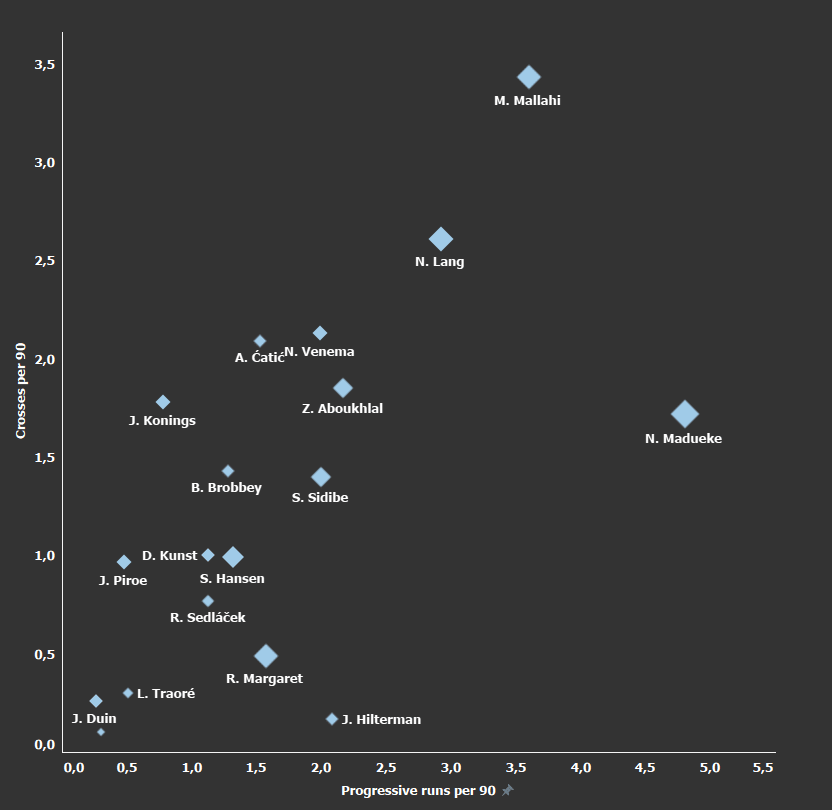
Unfortunately, the U21 team, similarly to the seniors, cannot choose from many promising options for the left-back and the ‘keeper spots. However, Shurandy Sambo had a very interesting campaign in the Eerste Divisie on the right flank of the team – as visualised in the next graph, he had the most successful defensive actions per 90 (17.28) which included 7.19 successful defensive duels and 1.93 successful aerial duels in average. Also, Sambo had the most interceptions (10.37) among right-backs under 20 and topped it with 8.29 accurate progressive passes per 90. Without doubt, he deserves to get his first minutes in the first tier, possibly in the left-back position, should there be no arrivals from the market during the summer transfer period.
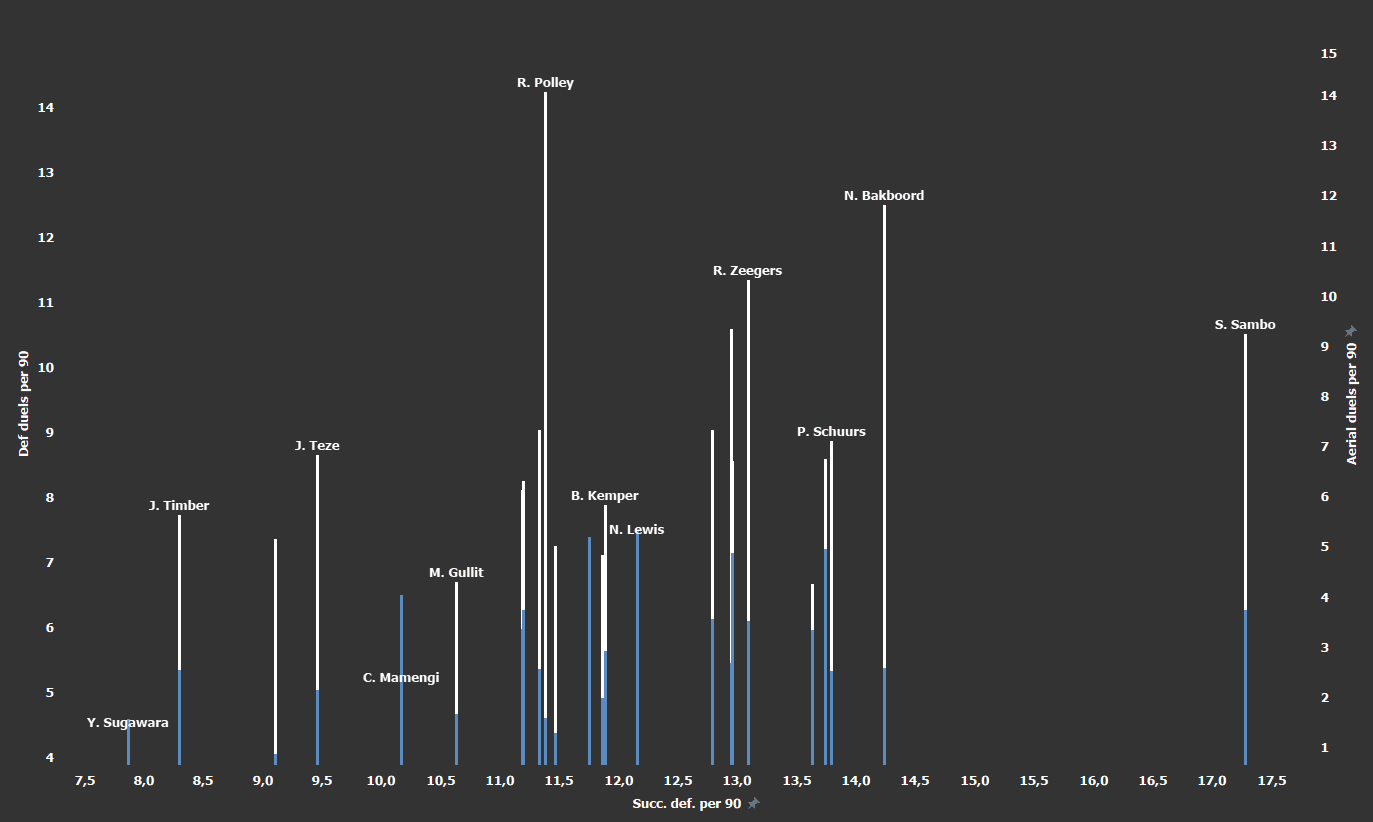
Market needs
With the new players returning from a loan spell or possibly stepping up from the reserves, PSV’s situation looks better but far from optimal. The three players with the most chance to play more minutes are Noni Madueke in the right-wing, Armando Obispo in central-defence, and Dante Rigo in the defensive midfield area. However, all the other issues remain unanswered: the club still desperately needs a goalkeeper, a left-back, and a winger. The fact that Roger Schmidt, who will take charge in July, has a crystal clear philosophy and requirements towards his players, makes it a bit easier for the club to detect the profiles they will need to look for at the market.
The ‘keeper role, apart from the fundamental aspects like being confident in the air, brave in one-on-one situations and have a quick reaction time, also contains being comfortable and reliable on the feet as well. In a possession-based team, the last man must be able to be involved in passing situations and short build-ups, to create a numerical advantage in the back when pressed high.
The left-back should join the attacks as frequently as possible – this was one of the main weaknesses of this role in the previous season. PSV are in the need of a modern full-back, similar to Denzell Dumfries on the other side, who does not shy from making progressive runs and supporting the wingers in the wide areas, but without leaving his defensive duties behind.
Up front, as we saw at the earlier stage of the analysis, there are many elements of the game in which the winger will be required to improve the team’s overall performance: mostly with progressive runs, accurate passes to the penalty area and dribbling. Another fundamental responsibility of the wide-man will be his pressing ability and his efficiency in defensive actions, as high and intensive pressing is the cornerstone of Roger Schmidt’s philosophy. When at the market, PSV has to look for balanced profiles who can both excel at their offensive and their defensive duties throughout the 90 minutes.
Conclusion
In this data analysis, our main goal was to identify the core problems of the PSV squad which was undoubtedly a significant factor in their below-expectations performance in the 2019/20 Eredivisie campaign. Firstly, we detected the weakest links of the team by comparing the squad’s performance to the league average in every position – as a result, it turned out that the most significant differences were between the sticks, in the heart of the midfield and at the right flank of the attacking line. After this, we took a look at the current state of the 2020/21 squad and identified two other weak spots: the left-back and the centre-back positions. Then, in the final part of the analysis, we checked how the team could rely on their new players – those who will return from a loan spell and the youngsters who are waiting for their chances – and where will be required a significant amount of effort regarding recruitment in summer.
There is no doubt that PSV’s chances to become title contenders again will increase with the arrival of Roger Schmidt but for glory, he will certainly need a few new faces in the squad. The conclusion is that the club must bring in a new ‘keeper, a left-back and a defensive midfielder at least, while a central defender and a right-winger would also be a necessity. Moreover, signing new players from the transfer market will not be the only task during the summer: as seven squad members have a contract expiring in 2021, the board has to pay attention to extend these agreements or sell the players still in the coming months. Surely, PSV Eindhoven will have a very busy transfer season which will determine their success both in the short run and for the coming years as well.






Comments